


| Otto's prototype Touch Guitar.Comments from Otto: This is the first stringed instrument I have built from soup to nuts. It has a body through neck construction using Flame Maple and Paduk. The body wings are Flame Maple. The fingerboard is Pau Fero, and has jumbo frets. I built it as a prototype, so I could figure out the mechanics of one of these things. There are no electronics, nor does it have a metal bridge. It plays well but I built it to what I jokingly call 'Russian Industrial Standards'. Everything that had to be finished, was, and everything else was not. In fact, if you look at one of the larger pictures of the headstock, you may see the pencil marks I used to lay out the tuning pegs. Its purpose in life, is as I stated above, is as a prototype. At some point, and about 5 more of these things, I intend to build touch/tap style instruments, and electric basses professionally. My main work in life at the moment is taking care of my 11 month old son, Liam. I expect that in a couple of years, I'll be able to open up shop and hang my virtual shingle out for all the world to see. |
Some things I plan to change for the next one:
1) A 34" scale: Getting strings for a 35" scale would be a pain, though D'Addario guitar strings do actually make the stretch on the treble side. However, this does mean that the tuning pegs are uncomfortably close. The standard for this style of instrument, with this tuning, is to tuned to a low C. Since mine is now tuned to a low B, the string tension, and therefore the tone will be about the same. I don't like the sound of a low B on a 34" scale bass, though there are a few out there that sound OK. I think it sounds sort of rubbery or flabby.
2) The body will be slightly longer: This will make the strap points closer to the middle of the instrument. It is a little neck heavy when tipped down. I still intend to make the bridge end of the body perpendicular to the neck, so that it can be rested on the floor and not fall over, unlike my old Fender Jazz.
3) A fully adjustable bridge: I have found someone who will make one for me.
4) Pickups: I still don't know how I am going to do this. I don't want to bug Bartolini, mostly because I don't want to step on anyone else's toes. Also Bartolini is in sunny California, and I am not. I prefer to have any suppliers I deal with on this side of the Mississippi. (fortunately Sperzel falls into this category)
5) The neck will be a different shape: It will have a more rounded in back, which means that the truss rods will have to be closer together. Also the headstock will be cut from the same blank as the rest of the neck. Currently, it is laminated between the neck and the fingerboard. It will have laminates of either wood or Carbon fiber on the top and back. This will be plenty to resist any stress the strings will put on it. Alembic, and a whole bunch of other people do it this way, and their stuff is fine.
A Note: most of the comments next to the pictures are Hacksaw's (drummer in our band Private Circus, but you know that, because you are on our web page). Mine are separated with *** in front of them.
The person modeling the guitar is Jerfo, who is likely to be Otto's first customer. The links below the pictures take you to larger versions of the same picture.
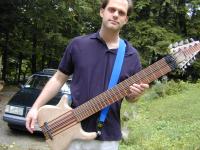
medium big | The guitar. 35" Scale &10 strings: From the top of the neck; ascending in 5ths (same as a 5 string bass, but upside down) G, D, A, E, B; then ascending 4ths; B, E, A, D, G (one octave higher, the E is the same as the low E on a guitar) |
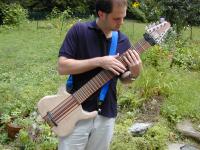
medium big | Jerfo seems to like it. |
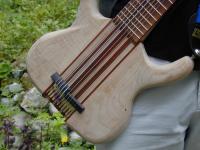
medium big | A closer look at the body. The stripes are from the neck, which is continuous, known as a "neck through body". Check out the nice laminating job. |
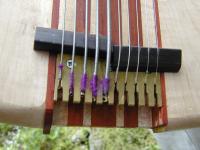
medium big | This is a the prototype bridge, in this case, two Ebony blocks, and the brass tail piece. These were constructed for proof of concept only. Successive guitars will have custom bridges like ones you'd find on fine guitars everywhere. |
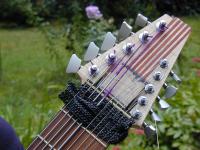
medium big | Note the arrangement of the tuning machines. Also a recap of the string of the neck. |
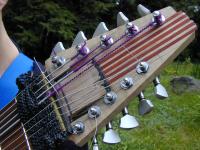
medium big | In closer you will note the black lines perpendicular to the
strings, one near the nut, and another farther up. These are the ends
of a lower carbon fiber/maple laminate that is part of the neck
sandwich. The laminate piece itself is two layers of 3 ounce
unidirectional carbon cloth, about .25" of rock maple, and a
layer of 3 ounce woven cloth on the top. This was epoxied into a wide
groove in the neck, and set as deep as possible. The unidirectional
cloth is in tension to resist the string pull, and the woven cloth
gives some resistance to twisting. Two truss rods are set on either
side of the lamination.
*** When the lamination first came out of the vacuum bag, I gave it to Hacksaw (our fearless drummer) to try to bend. He could get the end to deflect about 1/8" putting on hand in the middle and bracing the laminate between his other hand and his hip. This is before I put it in the neck. Even so, once the strings were put on and brought up to tension, the neck did have some deflection in it. As soon as the truss rods were tightened a little bit, it flattened right out. |
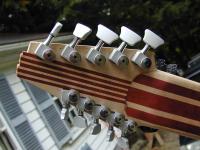
medium big | A better look at the stripes on the headstock and neck. Also note the Sperzel tuning machines. |
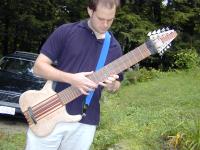
medium big | Jerfo likes how it plays |
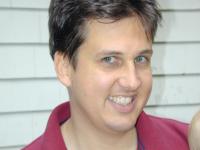
medium big | Otto is pleased. |
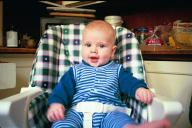
medium big | Liam is pleased, but probably because Otto is standing behind the camera, acting like a crazy man. |